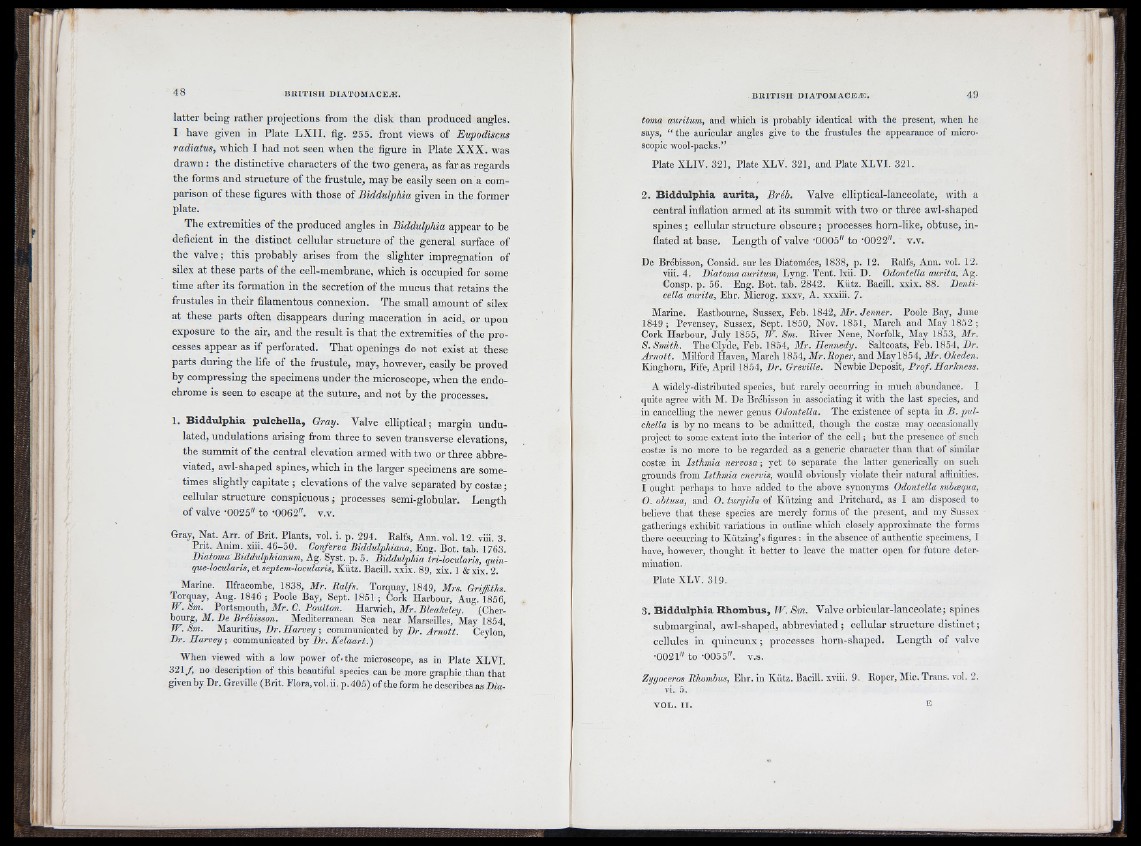
latter being ratlier projections from the disk than produced angles,
I have given in Plate LX II. fig. 255. front views of Eupodiscus
radiatus, which I had not seen when the figure in Plate X X X . was
drawn : the distinctive characters of the two genera, as far as regards
the forms and structure of the frustule, may be easily seen on a comparison
of these figures with those of Biddulphia given in the former
plate.
The extremities of the produced angles in Biddulphia appear to be
deficient in the distinct cellular structure of the general surface of
the valve; this probably arises from the slighter impregnation of
silex at these parts of the cell-membrane, which is occupied for some
time after its formation in the secretion of the mucus that retains the
frustules in their filamentous connexion. The small amount of siiex
at these parts often disappears during maceration in acid, or upon
exposure to the air, and the result is that the extremities of the processes
appear as if perforated. That openings do not exist at these
parts during the life of the frustule, may, however, easily be proved
by compressing the specimens under the microscope, when the endochrome
is seen to escape at the suture, aud not by the processes.
1. Biddulphia pulchella, Gray. Valve elliptical; margin undulated,
undulations arising from three to seven transverse elevations,
the summit of the central elevation armed with two or three abbreviated,
awl-shaped spines, which in the larger specimens are sometimes
slightly capitate ; elevations of the valve separated by costæ ;
cellular structure conspicuous ; processes semi-globular. Length
of valve -0025" to -0062". v.v.
Gray, Nat. Arr. of Brit. Plants, vol. i. p. 294. Ralfs, Ann. vol. 12. viii. 3 .
Prit, Anim. xiii. 46-50. Conferva Biddulphiana, Eng. Bot. tab. 1763.
Biatoma Biddulphianum, Ag. Syst. p. 5. Biddulphia tri-locularis, quin-
que-locularis, et septem-locularis, Kiitz. Bacill. xxix. 89, xix. 1 &xix. 2.
Marine. Ilfracombe, 1838, Mr. Balfs. Torquay, 1849, Mrs. Griffiths.
Torquay, Aug. 1846; Poole Bay, Sept. 1851; Cork Harbour, Aug. 1856,
W.Sm. Portsmouth, Mr. C. PoMtton. Harwich, Mr. Bleaheley. (Cherbourg,
M. He Rre'Siaso«. Mediterranean Sea near Marseilles, May 1854,
W. Sm. Mauritius, Hr. Harvey ; communicated by Dr. Arnott. Ceylon’
Dr. Harvey, communicated by Hr. AeZfflari.)
When viewed with a low power of. the microscope, as in Plate XLVI.
321/, no description of this beautiful species can be more graphic than that
given by Dr. Greville (Brit. Flora, vol.ii. p.405) of the form he describes as Diatoma
auritum, and which is probably identical with the present, when he
says, “ the auricular angles give to the frustules the appearance of microscopic
wool-packs.”
Plate XLIV. 321, Plate XLV. 321, and Plate XLVI. 321.
2. Biddulphia aurita, Bréb, Valve elliptical-lanceolate, with a
central inflation armed at its summit with tw'O or three awl-shaped
spines ; cellular structure obscure ; processes horn-like, obtuse, inflated
at base. Length of valve -0005" to ’0022". v.v.
De Brébisson, Consid. sur les Diatomées, 1838, p. 12. Ralfs, Ann. vol. 12.
viii. 4. Diatoma auritum, Lyng. Tent. ixii. D. Odontella aurita, Ag.
Consp. p. 56. Eng, Bot. tab. 2842. Kiitz. Bacill. xxix. 88. Denti-
cella aurita, Ehr. Microg. xxxv, A. xxxiii. 7.
Marine. Eastbourne, Sussex, Feb. 1842, Mr. Jenner. Poole Bay, June
1849 ; Pevensey, Sussex, Sept. 1850, Nov. 1851, March and May 1852 ;
Cork Harbour, July 1855, W. Sm. River Nene, Norfolk, May 1853, Mr.
S. Smith. Tlie Clyde, Feb. 1854, Mr. Hennedy. Saltcoats, Feb. 1854, Dr.
Arnott. Milford Haven, March 1854, Mr.Boper, and Mayl854, Mr. Okeden.
Kinghorn, Fife, April 1854, Hr. Greville. Newbie Deposit, Prof. Harkness.
A widely-distributed species, but rarely occurring in much abundance. I
quite agree with M. De Brébisson iu associating it with the last species, and
in cancelling the newer genus Odontella. The existence of septa in B. pulchella
is by no means to be admitted, though the costæ may occasionally
project to some extent into the interior of the cell ; but the presence of such
costæ is no more to be regarded as a generic character than that of similar
costæ in Isthmia nervosa-, yet to separate the latter generically on such
grounds from Isthmia enervis, would obviously violate their natural affinities.
I ouglit perhaps to have added to the above synonyms Odo-ntella suboequa,
O. obtusa, and 0. turgida of Kützing aud Pritchard, as I am disposed to
believe that these species are merely forms of the present, and my Sussex
gatherings exhibit variations in outline which closely approximate the forms
there occurring to Kützing’s figures ; in the absence of authentic specimens, I
have, however, thought it better to leave the matter open for future determination.
Plate XLV. 319.
3. Biddulphia Rhombus, W. 8m. Valve orbicular-lanceolate; spines
submarginal, awl-shaped, abbreviated ; cellular structure distinct ;
cellules in quincunx ; processes horn-shaped. Length of valve
•0021" to -0055". v.s.
Zygoceros Bhombus, Ehr. iu Kütz. Bacill. xviii. 9. Roper, Mic. Trans, vol. 2.
vi. 5.
V O L . I I . E